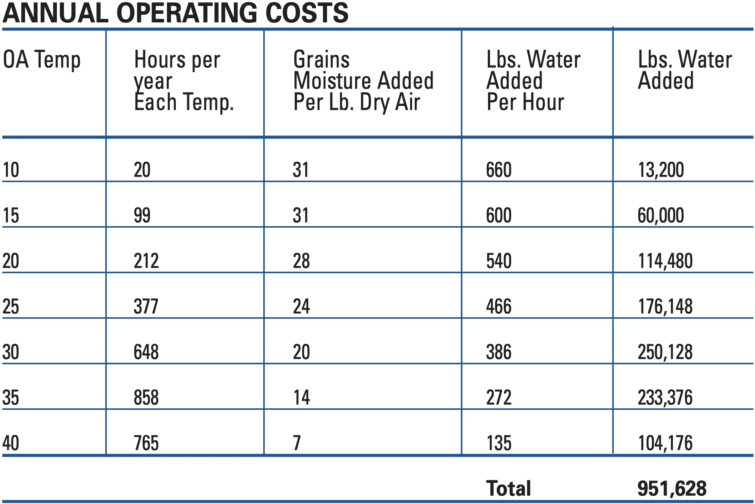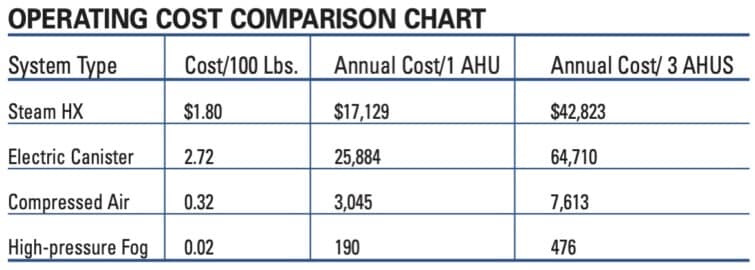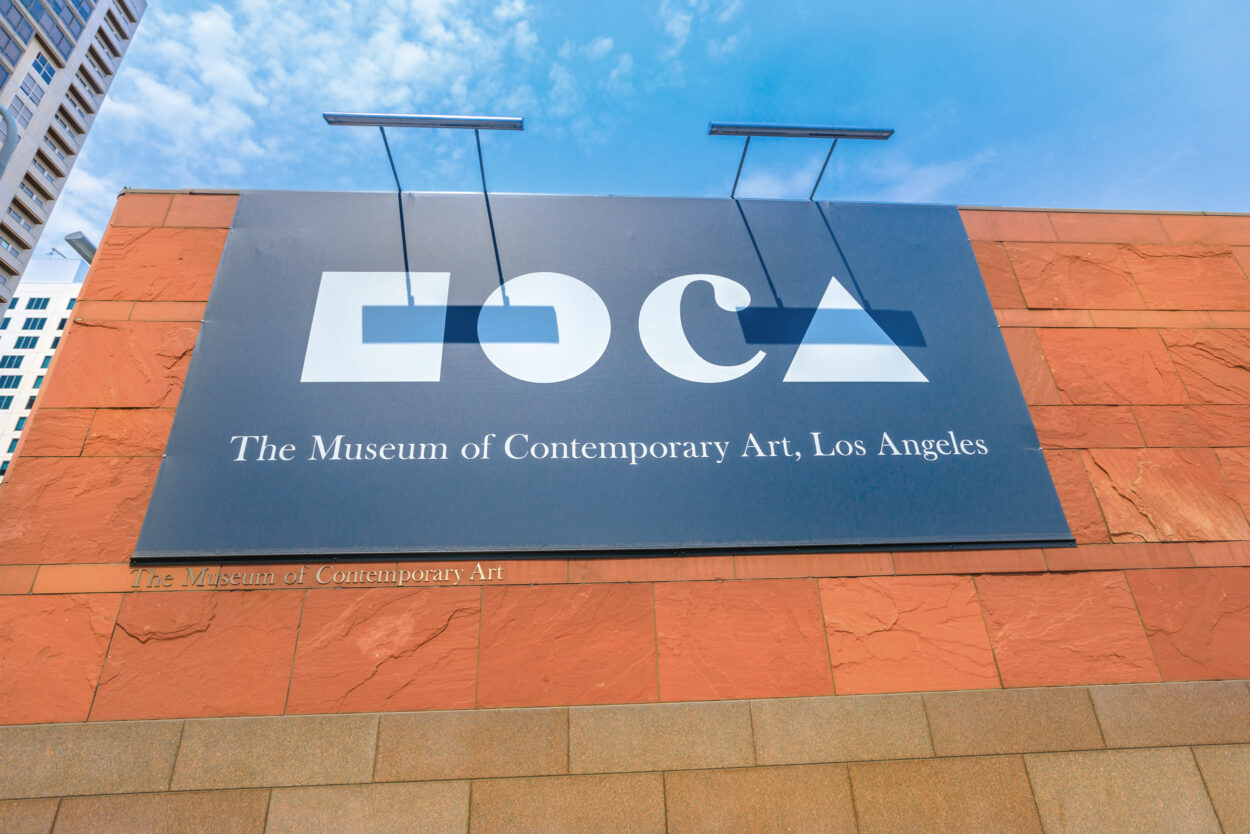Humidification Systems: A Cost and Efficiency Comparison
HVACThe requirements of modern industrial processes, as well as more stringent indoor air quality (IAQ) standards, have resulted in an increased demand for effective humidification control of both industrial and commercial indoor spaces. ASHRAE Standard 62-1989, for instance, states, “Relative humidity in habitable spaces preferably should be maintained between 30% and 60%… to minimize growth of allergenic and pathogenic organisms.” (Section 5.11)
A number of humidification solutions, both old and new, are available to fill this demand. Each is discussed below, followed by a detailed comparison in terms of humidification effectiveness, IAQ, installation costs, and operating costs.
Boiler Steam Humidifiers:
Many buildings were originally equipped with steam humidifiers as a byproduct of the traditional boiler room. Fueled by either gas or electricity, water is boiled to provide hot water, heat, and humidity for an entire building. To add humidity, boiler steam is released directly into the air stream.
Steam humidifiers offer distinct advantages. They introduce water in the vapor phase directly into the air stream, and therefore can often be applied in tight spaces without causing wetting of the ducts. However, since steam humidification results in a substantial increase in the dew point of the air stream, care must be taken to avoid downstream condensation on duct surfaces. Additionally, if an operational boiler room already exists, a humidification retrofit has relatively low first costs.
Boiler steam humidification, however, has fallen out of favor. Boiler steam contains chemicals that are dangerous to both people and materials. Therefore, boiler steam humidification is now considered unacceptable from an indoor air quality (IAQ) standpoint.
Clean Steam Humidifiers:
In response to the health hazard posed by boiler steam humidification, a variety of steam alternatives have evolved. The clean steam humidifier, for example, consists of a dedicated steam generator used only for humidification. The steam generator can be either an electric boiler or a gas-fired boiler. Since make-up water must not be chemically treated, softened water is normally used to reduce the buildup of minerals inside the boiler as well as inside the treated spaces. To prevent rust, stainless steel boiler vessels are employed. Although clean steam provides good humidification effectiveness and acceptable IAQ, it has relatively high operating costs.
Steam Heat Exchanger Humidifiers:
Another solution to the unsafe nature of boiler steam is the steam-to-steam heat exchanger humidifier (HX). These systems achieve clean steam humidification by separating building steam from humidification steam via a heat exchanger. Boiler steam is used to evaporate chemical-free, demineralized water in a tank, converting it to clean steam.
A steam HX system provides the advantages of a clean steam humidifier without the floorspace requirement of a dedicated boiler. By using partially demineralized make-up water, mineral residue is reduced, keeping maintenance costs down.
The main drawbacks of this form of steam humidification, as with boiler steam humidification, are high initial investment and running costs. Generally speaking, compared to other methods of humidification, steam systems cost more to install and a lot more to run.
Canister Steam Humidifiers:
This type of clean steam humidification system has lower first costs as compared to boiler-type humidifiers. Canister-type units are easy to install and particularly suited to smaller areas, though some models are designed for up to 1,140 lbs. per hour. Overall, canister humidifiers provide good humidification effectiveness and IAQ.
However, operating costs for electric canister humidifiers tend to be quite high, due to higher unit cost of electric power as compared to natural gas. Additionally, maintenance can be expensive when replaceable water canisters are utilized as a solution to mineral buildup on heating electrodes. Maintenance costs, however, can be lowered somewhat if the water supply is softened.
Cold-Water Humidification Systems:
Cold-water fogging is an adiabatic process. It uses heat in the air to evaporate water. In many commercial systems, economizers can be used to capture waste heat which can be used to evaporate the fog droplets. This method is popular due to its low operating cost, low environmental impact, controllability, and ease of incorporation into existing HVAC installations.
Several types of cold-water humidification systems are in common use in commercial and industrial applications. All these systems use a relatively small amount of energy to atomize water into small droplets, then heat from the treated space is used to do the actual evaporation. Some of the more common cold-water humidification systems are discussed below.
Water Treatment Considerations:
With cold-water humidification systems it is important to use only water with minerals removed by reverse osmosis or with naturally low mineral content. Steam-type systems vaporize the humidification water in a tank so that any minerals present in the supply water are left behind in the tank. However, cold-water humidification systems evaporate small droplets of the supply water in the air stream itself. Any mineral content present in the atomized water droplets is left in the air stream in the form of a dust particle.
As an example, if a cold-water humidification system that generates 1,000 lbs/hr. of moisture is used with supply water that has 100 parts per million, by weight of mineral content, it will generate one pound of mineral dust every ten hours. Over time, this can cause quite a housekeeping problem even in a large space. Furthermore, since naturally occurring waters generally contain high levels of calcium, magnesium, and sodium, it is important to study the effect of these minerals on any manufacturing process. Mineral dust would, for instance, cause significant problems in a computer clean room application.
Another point to consider is the potential for bacterial fouling of the supply water. Water supplied from municipal treatment plants is normally treated with chlorine. But the chlorine must be removed when water is demineralized with reverse osmosis technology, otherwise it would damage the osmotic membranes. Reverse osmosis systems are the most common and least expensive type of system used to remove mineral content for humidification applications. The demineralized, and now dechlorinated water is often stored in a tank where it could easily be contaminated by bacteria. Usually, the water is kept free of bacteria by UV sterilization, it is also important to ensure that water is not left to stagnate for extended periods of time in any part of the humidification system, staging valves can be run in intervals to flush the lines.
Centrifugal Humidifiers:
In centrifugal humidification, water is sprayed at low-pressure against a spinning disc, harnessing centrifugal force to atomize the water. This kind of system has several advantages, such as low operating cost and low first cost. Overall, it is an energy efficient method that is most suited to humidification of small industrial spaces (such as a small woodworking or printing shop) or agricultural applications. Due to the size of the units, centrifugal humidifiers are not generally applied in ducted air systems, with the exception of smaller systems for home use.
Ultrasonic Humidifiers:
Ultrasonic humidifiers operate by means of a transducer that sits in a shallow water bath. The transducer converts high frequency electricity into mechanical oscillation, causing small droplets to break away from the surface of the water bath and become airborne. Demineralized water is normally used, both to prevent mineral buildup on the transducers and to eliminate mineral dusting of the treated spaces.
Ultrasonic humidifiers are more energy efficient than steam or centrifugal humidifiers, though IAQ is a concern in some models due to open water baths, which can promote bacterial growth. New generation ultrasonic humidifiers are addressing this IAQ situation, utilizing a variety of methods to minimize bacterial dangers.
Compressed Air Atomizers:
Compressed air atomizing nozzles discharge a high velocity air stream around a water orifice. The high velocity air stream creates a vacuum at the orifice tip, which shears the water into particles. Droplet sizes range from sub-micron to 30-microns in diameter, depending on the velocity of the atomizing air.
Compressed air atomizers should also be used with demineralized water to meet IAQ standards and to avoid dusting from mineral salts found in normal tap water. They have been successfully applied in some industrial applications where the nozzles are located in the plant itself, with waters having as much as 250 parts per million (ppm) of dissolved mineral content.
As with any humidification system that functions without making steam, operating costs are relatively low. When compressed air atomizers are installed in air ducts or air handling units, the latest models have been able to achieve evaporation distances close to that of steam by increasing air pressure, but this does increase energy consumption.
The primary drawback of compressed air atomizers, however, is operating costs. Though they are low compared to steam-type systems, compressed air atomizers can sometimes be cost prohibitive in larger facilities.
High-Pressure Cold-Water Fogging:
High-pressure cold-water fogging operates in a fashion similar to other cold-water humidification systems, in that they all generate small water droplets and use heat from the space to affect evaporation. But fog achieves small particle sizes through the utilization of pressurized water which is inherently a more energy-efficient method.
The typical high-pressure fogging system consists of a high-pressure pump, which delivers water at 1,000 psi to a series of fog nozzles. A typical fog nozzle has an orifice diameter of five to seven thousandths of an inch. Water jets out of the orifice and hits the impaction-pin, which breaks the water stream up into billions of micron-sized droplets. Some fog nozzles create as many as five billion super-fine fog droplets per second, with droplets averaging about five microns in diameter.
High-pressure fog systems can be controlled by using solenoid valves to turn on stages of fog nozzle lines, using four valves allows for 7% increments in output. A high-pressure pump with a variable frequency drive is used to maintain the pressure at 1,000 psi as output adjusts. Standard turndown ratio is 30% but pumps can be operated at low or no discharge with added heat exchangers. The space requirement for the high-pressure pump systems is minimal and the first cost is often less than that of both steam and compressed air systems. Maintenance costs, also, are relatively low, mainly involving replacement of water filters and service to the high-pressure pumps. The biggest advantage of high-pressure cold-water fogging, though, is running costs. (See Below Energy Cost Comparison – Economizer.)
A typical fog system uses one horsepower for every 500 lbs. of water, which is about three percent of the energy usage of compressed air-type systems and about one percent of the energy usage of steam systems. When calculating the maximum payback for fog systems we take an example of an air handler that requires a maximum of 20% outside air, and has a space dewpoint of about 44°F. In this example there are no additional BTUs added to the system in order to offset the MeeFog. That means you are only paying for the electrical energy used by the fog pump motor and RO system.
Energy Cost Comparison

Humidity load is higher with steam due to a larger outside air percentage, while fogging allows for a higher percentage of return air, adding enough BTUs to the mixed air stream to offset the evaporative cooling with waste heat.
Energy and Cost Comparison of Humidification Systems

Cold-water fogging, however, is generally only cost-effective for installations requiring more than 200 lbs. per hour of water. Below this level, installation costs are high as the cost of the high-pressure pump needed for a small application does not drop proportionally. Additionally, high-pressure fog has a longer evaporative distance than steam and requires the use of a fog droplet filter to remove droplets that don’t evaporate quickly enough. The fog droplet filter is positioned downstream of the nozzle manifold to prevent wetting of the ducts.
Case Study: Cost Comparison
A U.S. postal site in Washington, DC, originally had building steam humidification which was discontinued for IAQ reasons. The facility requested quotes from various vendors. Clean steam humidification was out of the question due to space limitations. Centrifugal humidification was also rejected due to IAQ, while ultrasonic humidifiers were deemed unfit for such a large site due to the amount of space that would be taken up by system equipment. That left steam HX (heat exchanger), electric canister steam, compressed air, and high-pressure cold-water fogging. Each of these candidates were evaluated against four criteria: humidification effectiveness, first cost, IAQ acceptability, and annual operating costs.
For the purposes of price calculation, loads were estimated at approximately 4,120 lbs. per hour for each air handling unit (AHU); based on outside air temperature minimum of 10°F, winter supply air temperature of 60°F, winter room temperature of 70°F, night setback temperature of 55°F, and a minimum relative humidity of 40%. Each AHU had a capacity of 265,000 CFM, with a total of three units existing at the facility.
Humidification Effectiveness:
Humidification effectiveness was defined as a measure of a system’s ability to add moisture to the air to the point of saturation, as well as to achieve precise control of humidity levels. While all of the four systems tested produced acceptable levels of humidity for this application, on a scale of one to ten, where ten is the best, steam HX scored highest on humidification effectiveness, due to the fact that steam is water vapor. Electric canister steam placed second, with fog and compressed air tying for third. (See Figure 2.)

This chart compares the features of each system, based on a scale of 1-10, with 10 being the best.
First Cost:
The estimates below were obtained from a respected East Coast manufacturer’s representative.

In this example, high-pressure fog worked out to be the cheapest to install, coming in at 67% less expensive than steam HX, due to the low cost of installation equipment. Note that electric canister humidifier equipment costs are close to those of high-pressure fogging, though if upgrade of electric service is required, first costs grow accordingly.
Indoor Air Quality:
IAQ standards make it essential that no potentially harmful chemicals be introduced into the air, and that no environment that supports bacterial growth be used in building humidification. Each of the systems considered provide IAQ which falls well within OSHA regulations. HX scored best again, followed by electric, with cold water fog and compressed air tied once more. (See Figure 3.)

This chart compares the indoor air quality features of each humidification system, based on a scale of 1-10, with 10 being the best.
Annual Operating Costs:
It is in the area of operating costs that the most dramatic differences are noted. Outside air was estimated at 135,000 of lbs. dry air per hour. Detailed calculations were conducted as to the amount of moisture that would need to be added per year, based on a system of five degree temperature bins taken from Chapter 30 of the ASHRAE Handbook of Fundamentals, as follows:

Thus, one typical AHU requires 951,628 lbs. of moisture for humidification each year. When considering three units, however, consumption is only 2.5 times that amount, due to increased system efficiency. Energy costs per 100 lbs. of water added, work out as follows:
| System Type | Energy Use | Energy Cost | Cost of Operation | Net Cost | Notes |
| Steam HX Humidifier | 1 lb of humidification steam requires 1,000 BTUs of fuel. | $0.08 per 1,000 BTUs | $1.80 per 100 lbs of humidification | $0.12 x 1.5 = $0.18 per 1,000 BTUs | Fuel efficiency = 80% = $0.10 per 1,000 BTUs. Adding a skimmer to a steam generator increases fuel consumption by 50%. |
| Electric Canister Humidifier | A 10 kW electric canister humidifier uses 1 kWh to produce 2.94 lbs/hr of steam. | $0.08 kWh | $2.72 per 100 lbs of humidification | Efficiency = 100% | |
| Compressed Air Humidifier | ~1 kW of electrical power to 4.5 cfm of compressed air which will produce 25 lbs/hr of atomized water. | $0.08 kWh | $0.32 per 100 lbs of humidification | ||
| High-pressure Fog System | Fog pump requires 5 kW for 2,000 lbs/hr of fog.* | $0.08 kWh | $0.02 per 100 lbs of humidification | *This figure takes into account losses on fog droplet filters |

In summary, while steam HX scores slightly higher on IAQ and humidification effectiveness, high first costs prohibit its use in many applications. Electric canister humidification, while having considerably lower installation costs than HX, compares poorly when viewed in terms of energy consumption. Compressed air, despite being far superior to steam HX and electric canister in terms of energy consumption, consumes 15 times more power than high-pressure fog. Fog delivers acceptable IAQ and humidification effectiveness while keeping both installation and operating costs down. Of course, these estimates may vary from site to site, but in many facilities requiring more than 250 lbs/hr. of water, high-pressure fogging works out to be an option worth serious consideration.

